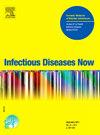Cholera outbreak in Mayotte (France): A retrospective description of 16 patients treated for hypovolemia in the ICU
IF 2.2
4区 医学
Q2 INFECTIOUS DISEASES
引用次数: 0
Abstract
Objectives
To describe the presentation and therapeutic management of severe cholera in Mayotte (France).
Patients and methods
We carried out retrospective data collection. All patients treated in the intensive care unit (ICU) with a confirmed diagnosis of cholera by PCR were studied. Only patients treated for hypovolemia were included.
Results
Out of the 215 confirmed cases of cholera in Mayotte on July 12, 2024, 25 required treatment in the ICU (11.6 %). Among these cases, 16 were treated for hypovolemia (7.4 %), while five patients died of cholera before they could be admitted to hospital (lethality rate 2.3 %). No patient died in hospital.
Median patient age was 17 years (4–30) with a sex ratio of 1. Severe diarrhea was the rule with a median of one diarrheal stool every two hours. Clinical severity was characterized by sunken eyes and Glasgow Coma Scale (GCS) < 14 (n = 16/16,100 %). Biological severity was determined by profound metabolic acidosis with venous pH < 7.20 (n = 16/16, 100 %). Intravenous fluid therapy was aggressive with a median of 280 mL/kg (230–300) Ringer’s lactate solution during the first 48 h.
Conclusions
Cholera can be a life-threatening infection, with deaths occurring due to severe diarrhea and hypovolemia. From the onset of symptoms, which are sometimes fulminant, patients must be admitted to a care center as soon as possible. We will continue to collect data to create scores that will enable us to better recognize the most severe forms of the disease.
马约特(法国)霍乱暴发:对ICU治疗低血容量患者的16例回顾性描述。
目的:描述法国马约特省严重霍乱的表现和治疗管理。患者和方法:我们进行回顾性资料收集。对所有经PCR确诊为霍乱的重症监护病房(ICU)患者进行了研究。仅包括因低血容量而接受治疗的患者。结果:2024年7月12日,马约特省215例霍乱确诊病例中,需在ICU治疗的25例(11.6% %)。在这些病例中,16例因低血容量而接受治疗(7.4% %),而5例患者在入院前死于霍乱(致死率2.32% %)。没有病人在医院死亡。患者中位年龄为17 岁(4-30岁),性别比为1。严重腹泻是规律,平均每两小时就有一次腹泻。临床严重程度以眼部凹陷和格拉斯哥昏迷评分(GCS)为特征 结论:霍乱是一种危及生命的感染,可因严重腹泻和低血容量导致死亡。从症状开始,有时是暴发性的,患者必须尽快住进护理中心。我们将继续收集数据,创造分数,使我们能够更好地识别最严重的疾病形式。
本文章由计算机程序翻译,如有差异,请以英文原文为准。
求助全文
约1分钟内获得全文
求助全文
来源期刊

Infectious diseases now
Medicine-Infectious Diseases
CiteScore
7.10
自引率
2.90%
发文量
116
审稿时长
40 days
 求助内容:
求助内容: 应助结果提醒方式:
应助结果提醒方式:


